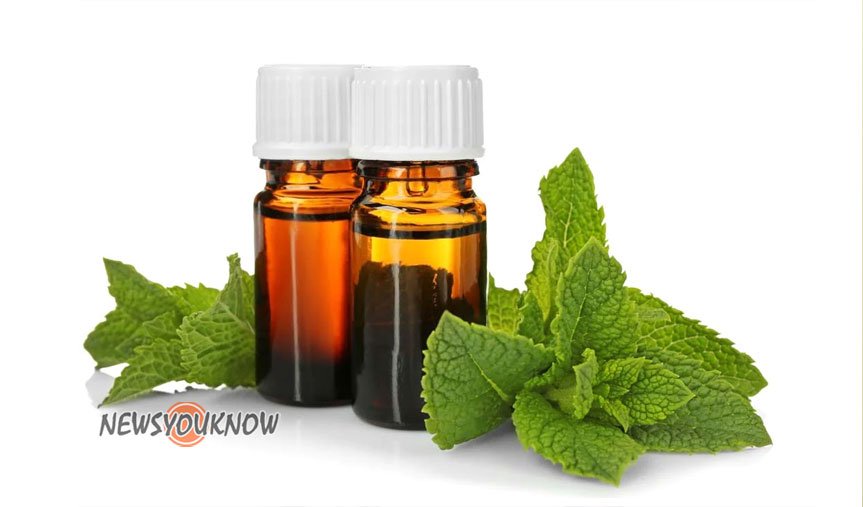Peppermint oil is a popular essential oil used for its invigorating and soothing properties. However, this strong-smelling oil can sometimes irritate sensitive skin when applied topically. If you’ve gotten peppermint oil on your skin and want to remove it quickly, there are several simple and effective methods you can use.
Why Peppermint Oil May Need to Be Removed
Peppermint oil provides many benefits when used aromatically or topically on the skin. However, it is very concentrated and contains menthol, which gives it a cooling, tingly sensation. For some people, topical peppermint oil can cause:
- Redness
- Burning or stinging
- Itching
- Rashes
If you experience any irritation after putting peppermint oil on your skin, it’s important to wash it off right away. Leaving the oil on can make your symptoms worse.
Peppermint oil is also very strong smelling. If you’ve gotten it on your hands, body or clothes, you’ll likely want to remove the scent.
Act Quickly for Best Results
Don’t wait to wash peppermint oil off your skin. Acting quickly will help lift the oil and prevent increased irritation and absorption into your skin.
Start the removal process as soon as possible after contact with the oil. The longer you wait, the more difficult it will be to fully eliminate the peppermint smell and residue.
Use Mild Soap and Water
One of the simplest ways to get peppermint oil off your skin is to wash with mild soap and water. This method works well for removing small amounts of oil.
What You’ll Need
- Mild liquid soap or cleanser
- Warm water
- Washcloth or soft towel
Step-By-Step
- Wet the area of skin where the peppermint oil spilled with warm water. Warm water can help dissolve and lift the oil.
- Dispense a small amount of mild, fragrance-free soap or cleanser onto your hands or washcloth. Liquid soap works better than bar soap for removing oils.
- Gently massage the soap onto the affected area of skin for 30-60 seconds. Be careful not to rub too harshly.
- Rinse thoroughly with warm water. The soap will lift away the peppermint oil.
- Pat dry with a clean, soft towel. Avoid rubbing, which may irritate skin.
- Repeat if any oil residue remains on the skin.
Using a gentle touch is important when washing off peppermint oil. Vigorous scrubbing can increase skin irritation.
Use Baby Shampoo
For a very mild cleanser, try using baby shampoo to wash peppermint oil off your skin. The formula is extra gentle and won’t dry out your skin.
What You’ll Need
- Baby shampoo
- Warm water
- Washcloth
Step-By-Step
- Wet the affected area with warm water.
- Squeeze a small amount of baby shampoo onto your hands or a washcloth.
- Gently massage the shampoo into your skin for 30-60 seconds to lift the oil.
- Rinse thoroughly with warm water.
- Pat dry with a clean towel. Be very gentle.
- Repeat if needed to remove the oil entirely.
The moisturizers in baby shampoo help prevent your skin from drying out, while effectively cleansing away impurities.
Use Exfoliating Scrub
For concentrated peppermint oil or oil stains, an exfoliating scrub can help lift and dissolve the oil. The granulated texture gently lifts residue away.
What You’ll Need
- Exfoliating scrub
- Warm water
- Washcloth
Step-By-Step
- Apply a small amount of exfoliating scrub onto the affected area.
- Gently rub the scrub onto your skin for 1-2 minutes using circular motions. Do not scrub harshly.
- Rinse thoroughly with warm water until all traces of the scrub and oil are gone.
- Pat dry with a clean washcloth. Be very gentle patting the area.
- Moisturize after to soothe any irritation. Avoid using lotions with fragrance.
Look for an exfoliating scrub with jojoba beads or soft nut shells. Avoid any scrubs with harsh plastic microbeads.
Use baking soda
Baking soda can be used as a gentle exfoliating scrub to lift away peppermint oil. It also neutralizes odors, helping remove any lingering scent.
What You’ll Need:
- Baking soda
- Warm water
- Washcloth
Step-By-Step:
- In a small bowl, mix 2-3 tablespoons of baking soda with a few drops of warm water to form a paste.
- Apply the paste to the affected area and gently rub for 1-2 minutes.
- Rinse thoroughly with warm water.
- Pat dry with a clean washcloth.
- Apply a fragrance-free moisturizer if needed to prevent dryness.
The baking soda paste is mild enough for regular use. Rinse thoroughly to prevent skin dryness.
Use Apple Cider Vinegar
Apple cider vinegar is another common household item that can help remove essential oils like peppermint. It helps balance skin pH and break down oil bonds.
What You’ll Need:
- Apple cider vinegar
- Water
- Cotton pads or washcloth
Step-By-Step:
- Mix equal parts apple cider vinegar and water.
- Soak a cotton pad or washcloth in the solution.
- Blot the affected area for 2-3 minutes to lift and dissolve the oil.
- Rinse with cool water and pat dry.
- Repeat as needed until the oil is gone.
Limit use of apple cider vinegar on sensitive areas like the face. Always dilute it with water before applying to skin.
Use Milk
Milk contains proteins and fats that help lift many types of oils and irritants off skin gently and effectively. The cool temperature is also soothing.
What You’ll Need:
- Milk (any variety will work)
- Water
- Washcloth
Step-By-Step:
- Pour milk into a bowl. Cool it in the fridge for 10-15 minutes if desired.
- Soak a clean washcloth in the milk. Wring out any excess.
- Drape the milk-soaked washcloth over the affected area for 2-3 minutes.
- Pat dry with a clean towel.
- Rinse with cool water and pat dry again.
- Repeat as needed until the peppermint oil is removed.
The proteins in milk cling to the essential oils and lift it away without irritating your skin.
Use Cleansing Oil
Using a cleansing oil is an easy way to dissolve and lift away peppermint oil from your skin quickly and efficiently. The oils attract and trap the residue.
What You’ll Need:
- Cleansing oil
- Warm washcloth
Step-By-Step:
- Apply a quarter-size amount of cleansing oil onto your hands.
- Massage the oil over the affected area for 30-60 seconds.
- Dip a washcloth in warm water and hold it over your skin for 20-30 seconds.
- Use the warm, damp cloth to gently wipe away the cleansing oil and peppermint oil.
- Repeat if needed until the peppermint oil is fully removed.
Look for a light, non-comedogenic formula like grapeseed or hemp oil. Avoid mineral oil, which can clog pores.
Avoid Harsh Ingredients
It’s important to use only very mild, non-irritating ingredients when removing peppermint oil from your skin. Harsher soaps, exfoliants and chemicals could make irritation worse.
Avoid products containing:
- Fragrance/perfumes
- Preservatives like parabens
- Harsh surfactants like sodium lauryl sulfate
- Acids like benzoyl peroxide
- Retinol
- Harsh scrubs with plastic microbeads
Stick to gentle, natural ingredients as much as possible. Always do a patch test before using anything new on your skin.
Rinse Thoroughly
No matter what method you use, be sure to rinse very thoroughly after washing peppermint oil off your skin. Any remaining residue could continue to cause irritation and discomfort.
Rinse with lukewarm, clean water for at least 30 seconds, rubbing gently with your hands to lift away any traces left behind. Pat dry with a soft cloth.
Moisturize After Cleansing
It’s a good idea to apply a gentle, fragrance-free moisturizer after cleansing peppermint oil off your skin. Washing with soap and water can disrupt your skin’s natural oils and leave it feeling tight and dry.
Look for thick, creamy moisturizers that contain ingredients like:
- Shea butter
- Coconut oil
- Hyaluronic acid
- Ceramides
- Jojoba oil
Avoid lotions with peppermint oil or other fragrances. Focus on hydrating and soothing your skin after cleansing.
When to Seek Medical Treatment
In most cases, washing peppermint oil off your skin using the methods above will resolve any irritation. But if your symptoms persist or worsen, seek medical attention right away.
Signs you may need medical care include:
- Rash spreading or getting more painful
- Blisters or burns
- Facial swelling
- Trouble breathing
- Dizziness or fainting
Severe allergic reactions to topical peppermint oil are rare but do happen. Seek emergency care if you experience any concerning symptoms.
Prevent Recurrence
Once you’ve removed peppermint oil from your skin, it’s a good idea to take steps to prevent it from happening again:
- Always do a patch test before using any new essential oil. Try it on a small area of the inner arm skin first.
- Dilute peppermint oil with a carrier oil to reduce strength if applying topically.
- Avoid getting oils on your hands to reduce spread. Apply with a cotton ball instead.
- Wear gloves when applying stronger oils like peppermint.
- Wash your hands after using essential oils.
- Keep oils tightly sealed when not in use to prevent accidental spilling.
- Store out of reach of children and pets.
Taking basic safety precautions will help prevent unwanted contact with potent oils like peppermint.
When Peppermint Oil Can Be Beneficial
While peppermint oil can sometimes cause skin irritation, it has many benefits when used carefully. It’s especially helpful for:
- Easing headache pain
- Relieving nausea
- Boosting energy levels
- Repelling insects
- Reducing stress and anxiety
- Improving focus and concentration
You can enjoy the benefits of peppermint oil aroma by diffusing it or inhaling directly from the bottle. For topical use, always dilute with a carrier oil first.
With proper precautions, peppermint oil can be a valuable addition to your health and wellness routine. Just take steps to remove it right away if any irritation occurs.
Conclusion
Peppermint oil is a concentrated essential oil that can sometimes irritate skin. If you get this strong oil on your skin, it’s important to wash it off as soon as possible. The best ways to remove peppermint oil from skin involve using gentle cleansers, exfoliants and natural remedies like baking soda, vinegar and milk. Dilute harsh soaps and exfoliants, limit rubbing, rinse thoroughly and always moisturize after cleansing. With the proper method, you can quickly get peppermint oil off your skin and avoid further irritation. Just take care when using peppermint oil in the future to prevent unwanted contact.













No Comment! Be the first one.